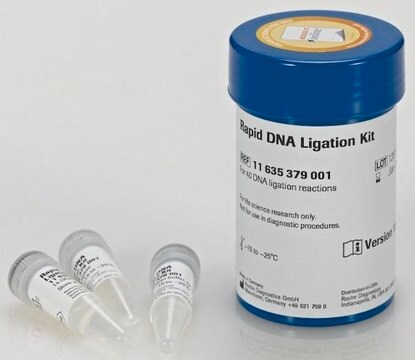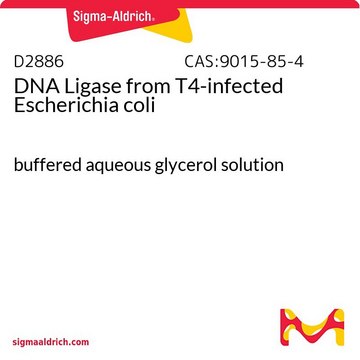LIG2
QuickLink™ DNA Ligation Kit
joins blunt-end and sticky-end DNA fragments
Synonym(s):
DNA Ligation Kit, Ligation Kit
About This Item
Recommended Products
grade
for molecular biology
Quality Level
form
liquid
usage
kit sufficient for 50 ligation reactions
technique(s)
molecular cloning: suitable
shipped in
dry ice
storage temp.
−70°C
General description
Application
- Joining blunt or cohesive-end fragments of DNA into a cloning vector
- Recircularization of linear DNA
- Formation of concatamers
- dsDNA nick repair
Features and Benefits
- Fast 5 minutes ligation
- High ligation efficiency
- Room temperature reactions – no cooling required
- Perform bacterial transformation with the reaction mixture
Components
- 500uL 2X Ligation Buffer A (L9537)
- 100uL 5X Ligation Buffer B (L9662)
- 250 units T4 DNA Ligase (D2886) in 50% glycerol with 10 mM Tris-HCl (pH 7.5) 50 mM KCl, and 1 mM DTT
Principle
Legal Information
related product
Storage Class Code
10 - Combustible liquids
Flash Point(F)
Not applicable
Flash Point(C)
Not applicable
Certificates of Analysis (COA)
Search for Certificates of Analysis (COA) by entering the products Lot/Batch Number. Lot and Batch Numbers can be found on a product’s label following the words ‘Lot’ or ‘Batch’.
Already Own This Product?
Find documentation for the products that you have recently purchased in the Document Library.
Protocols
T4 DNA ligase is used for the joining of DNA molecules with compatible cohesive (sticky) termini, joining of blunt ended double stranded DNA molecules
Our team of scientists has experience in all areas of research including Life Science, Material Science, Chemical Synthesis, Chromatography, Analytical and many others.
Contact Technical Service








